A Novel Approach to Achieve MPPT for Photovoltaic System Based SCADA
Abstract
1. Introduction
- To address the aforementioned disadvantages, a controller for MPPT is used in this study. The controller tracks the maximum power point (MPP) in real-time.
- To prevent failure in tracking the MPP under a rapid change in solar insolation, the authors of this study suggest an easy and precise MPPT technique. By considering the change in output current profile in addition to the conventional MPPT technique, the divergence problem and the steady-state power oscillation are diminished. Both fixed step sizes and variable step sizes are used to test the suggested modified ABC approach. Between the load and photovoltaic module, a dc-dc converter is necessary to implement this method. In order to achieve the MPPT’s goals, the classic boost converter is chosen and efficiently developed in this article based on system ratings.
- The goal of this effort is to create and implement a low-cost prototype for online monitoring of a PV system’s maximum power output. The prototype also includes a web portal that enables customers to view changes in the amount of power being generated by their installations in real time without exerting more effort or spending extra money. Verifying the effectiveness of some current MPPT algorithms using IoT technology in real time is another goal.
- Comparison to incremental conductance method, cuckoo search algorithm and an improved Artificial Bee Colony (ABC) algorithm is conducted.
2. Problem Formulation
- It enables two-way communication between the user and the simulated system, enabling real-time data sharing and remote control.
- A platform for communication that enables online real-time data sharing between MATLAB and ThingSpeak.
- Security—each channel has its own ID and can be either public (visible by other users) or private. User authentication is enabled via username and password (seen by specific users).
Modeling of Photovoltaic
Photovoltaic Modeling
3. MPPT Based on the IC Approach
4. Application of Cuckoo Search Algorithm toward MPPT
4.1. Lévy Flight
4.2. MPPT Using CSA
5. ABC Algorithm Application to MPPT
- (1)
- Initialization: In this piece, the employed bees are represented by one half of the colony, and the observers are represented by the other half. Using the following equation, all of these bees are initially placed in various food-source positions (i.e., duty ratio of the dc-dc converter) in a solution space.where and and denote minimum and maximum values of a duty-ratio.
- (2)
- Evaluating the quantity of nectar: The simulation study’s mathematical model is used to calculate output power in relation to each duty-ratio (food position). Bees are classified as employed workers or observers, depending on the amount of nectar.
- (3)
- Locating a new food source: Each cycle of the tracking MPPT of the photovoltaic system is carried out in two parts.
- (a)
- Employed bee phase: Each worker bee updates its location inside its neighborhood using the formula below:where denotes number of iterations, variable is a random number generated between , } is a randomly chosen index where
- (b)
- Onlooker phase: Waiting for observer bees in the dance area to come closer to the employed bee’s position where there is the most nectar available. This motion is described as:where denotes food source position.
- (4)
- Termination criterion: If, after five iterative rounds, the PV system detected by the bees does not produce any more power, end the algorithm and run a dc-dc converter at a best duty ratio.
- (5)
- Reinitiating the search: Restart the procedure if the change in power output indicates that the solar insolation has changed.
6. Proposed Communication Platform
- (a)
- Agent layer:
- (b)
- IoT platform layer:
- (c)
- Network layer:
- (d)
- Data processing layer:
- (e)
- Cloud layer:
7. Simulations Results
8. Discussion of Results
9. Conclusions
Author Contributions
Funding
Data Availability Statement
Conflicts of Interest
Abbreviations
| MPPT | Maximum Power Point Tracking |
| IoT | Internet of Things |
| IABC | Improved Artificial Bee Colony |
| PV | Photovoltaic |
| GMPP | Global Maximum Power Point |
| SCADA | Supervisory Control and Data Acquisition |
| V | Voltage |
| P | Power |
| WT | Wind Turbine |
| FC | Fuel Cell |
| SEPIC | Single-Ended Primary-Inductor Converter |
| IP | Internet Protocol |
| CS | Cuckoo Search |
| PSO | Particle Swarm Optimizer |
| PWM | Pulse Width Modulation |
| DERs | Distributed Energy Resources |
| BMC | Built-in MQTT Client |
| GUI | Graphical User Interface |
| IC | Incremental Conductance |
References
- Hafeez, M.A.; Naeem, A.; Akram, M.; Javed, M.Y.; Asghar, A.B.; Wang, Y. A Novel Hybrid MPPT Technique Based on Harris Hawk Optimization (HHO) and Perturb and Observer (P&O) under Partial and Complex Partial Shading Conditions. Energies 2022, 15, 5550. [Google Scholar] [CrossRef]
- Manoharan, P.; Subramaniam, U.; Babu, T.S.; Padmanaban, S.; Holm-Nielsen, J.B.; Mitolo, M.; Ravichandran, S. Improved Perturb and Observation Maximum Power Point Tracking Technique for Solar Photovoltaic Power Generation Systems. IEEE Syst. J. 2021, 15, 3024–3035. [Google Scholar] [CrossRef]
- Alhasnawi, B.N.; Jasim, B.H.; Sedhom, B.E.; Guerrero, J.M. Consensus Algorithm-based Coalition Game Theory for Demand Management Scheme in Smart Microgrid. Sustain. Cities Soc. 2021, 74, 103248. [Google Scholar] [CrossRef]
- Alhasnawi, B.; Jasim, B.; Siano, P.; Guerrero, J. A Novel Real-Time Electricity Scheduling for Home Energy Management System Using the Internet of Energy. Energies 2021, 14, 3191. [Google Scholar] [CrossRef]
- Alhasnawi, B.N.; Jasim, B.H. A new internet of things enabled trust distributed demand side management system. Sustain. Energy Technol. Assessments 2021, 46, 101272. [Google Scholar] [CrossRef]
- Alhasnawi, B.; Jasim, B.; Rahman, Z.-A.; Siano, P. A Novel Robust Smart Energy Management and Demand Reduction for Smart Homes Based on Internet of Energy. Sensors 2021, 21, 4756. [Google Scholar] [CrossRef] [PubMed]
- Alhasnawi, B.N.; Jasim, B.H. SCADA controlled smart home using Raspberry Pi3. In Proceedings of the 2018 International Conference on Advance of Sustainable Engineering and Its Ap-plication (ICASEA), Wasit-Kut, Iraq, 14–15 March 2018. [Google Scholar] [CrossRef]
- Priyadarshi, N.; Padmanaban, S.; Holm-Nielsen, J.B.; Bhaskar, M.S.; Azam, F. Internet of things augmented a novel PSO-employed modified zeta converter-based photovoltaic maximum power tracking system: Hardware realisation. IET Power Electron. 2020, 13, 2775–2781. [Google Scholar] [CrossRef]
- Adhya, S.; Saha, D.; Das, A.; Jana, J.; Saha, H. An IoT based smart solar photovoltaic remote monitoring and control unit. In Proceedings of the 2016 2nd International Conference on Control, Instrumentation, Energy & Communication (CIEC), Kolkata, India, 28–30 January 2016. [Google Scholar]
- Khan, M.J.; Kumar, D.; Narayan, Y.; Malik, H.; Márquez, F.P.G.; Muñoz, C.Q.G. A Novel Artificial Intelligence Maximum Power Point Tracking Technique for Integrated PV-WT-FC Frameworks. Energies 2022, 15, 3352. [Google Scholar] [CrossRef]
- Rouibah, N.; Barazane, L.; Benghanem, M.; Mellit, A. IoT-based low-cost prototype for online monitoring of maximum output power of domestic photovoltaic systems. ETRI J. 2021, 43, 459–470. [Google Scholar] [CrossRef]
- Fathy, A.; Ben Atitallah, A.; Yousri, D.; Rezk, H.; Al-Dhaifallah, M. A new implementation of the MPPT based raspberry Pi embedded board for partially shaded photovoltaic system. Energy Rep. 2022, 8, 5603–5619. [Google Scholar] [CrossRef]
- Khaleel, K.; Atyia, T.H.; Al-Naib, A.M.I. Design and Development of Re-al-Time Data Acquisition of Photovoltaic Panel Parameters via IoT. NTU J. Renew. Energy 2022, 3, 1–8. [Google Scholar]
- Rani, D.P.; Suresh, D.; Kapula, P.R.; Akram, C.M.; Hemalatha, N.; Soni, P.K. IoT based smart solar energy monitoring systems. Mater. Today Proc. 2021. [Google Scholar] [CrossRef]
- Malar, A.J.G.; Kumar, C.A.; Saravanan, A.G. Iot based sustainable wind green energy for smart cites using fuzzy logic based fractional order darwinian particle swarm optimization. Measurement 2020, 166, 108208. [Google Scholar] [CrossRef]
- Zafar, M.H.; Khan, N.M.; Mirza, A.F.; Mansoor, M.; Akhtar, N.; Qadir, M.U.; Khan, N.A.; Moosavi, S.K.R. A novel meta-heuristic optimization algorithm based MPPT control technique for PV systems under complex partial shading condition. Sustain. Energy Technol. Assess. 2021, 47, 101367. [Google Scholar] [CrossRef]
- Shams, I.; Mekhilef, S.; Tey, K.S. Maximum Power Point Tracking Using Modified Butterfly Optimization Algorithm for Partial Shading, Uniform Shading, and Fast Varying Load Conditions. IEEE Trans. Power Electron. 2021, 36, 5569–5581. [Google Scholar] [CrossRef]
- Nagadurga, T.; Narasimham, P.V.R.L.; Vakula, V.S.; Devarapalli, R.; Márquez, F.P.G. Enhancing Global Maximum Power Point of Solar Photovoltaic Strings under Partial Shading Conditions Using Chimp Optimization Algorithm. Energies 2021, 14, 4086. [Google Scholar] [CrossRef]
- Fares, D.; Fathi, M.; Shams, I.; Mekhilef, S. A novel global MPPT technique based on squirrel search algorithm for PV module under partial shading conditions. Energy Convers. Manag. 2021, 230, 113773. [Google Scholar] [CrossRef]
- Barbosa, E.J.; Cavalcanti, M.C.; Azevedo, G.M.D.S.; Bradaschia, F.; Limongi, L.R. Global Hybrid Maximum Power Point Tracking for PV Modules Based on a Double-Diode Model. IEEE Access 2021, 9, 158440–158455. [Google Scholar] [CrossRef]
- Chao, K.-H.; Li, J.-Y. Global Maximum Power Point Tracking of Photovoltaic Module Arrays Based on Improved Artificial Bee Colony Algorithm. Electronics 2022, 11, 1572. [Google Scholar] [CrossRef]
- Sayyad, J.; Nasikkar, P. Design and Development of Low Cost, Portable, On-Field I-V Curve Tracer Based on Capacitor Loading for High Power Rated Solar Photovoltaic Modules. IEEE Access 2021, 9, 70715–70731. [Google Scholar] [CrossRef]
- Kumar, V.; Mitra, A.; Shaklya, O.; Sharma, S.; Rana, K. An adaptive robust fuzzy PI controller for maximum power point tracking of photovoltaic system. Optik 2022, 259, 168942. [Google Scholar] [CrossRef]
- Dileep, G.; Singh, S. An improved particle swarm optimization based maximum power point tracking algorithm for PV system operating under partial shading conditions. Sol. Energy 2017, 158, 1006–1015. [Google Scholar] [CrossRef]
- Liu, Y.-H.; Huang, S.-C.; Huang, J.-W.; Liang, W.-C. A Particle Swarm Optimization-Based Maximum Power Point Tracking Algorithm for PV Systems Operating Under Partially Shaded Conditions. IEEE Trans. Energy Convers. 2012, 27, 1027–1035. [Google Scholar] [CrossRef]
- Rajasekar, N.; Vysakh, M.; Thakur, H.V.; Azharuddin, S.M.; Muralidhar, K.; Paul, D.; Jacob, B.; Balasubramanian, K.; Babu, T.S. Application of Modified Particle Swarm Optimization for Maximum Power Point Tracking under Partial Shading Condition. Energy Procedia 2014, 61, 2633–2639. [Google Scholar] [CrossRef]
- Mirhassani, S.M.; Golroodbari, S.Z.M.; Mekhilef, S. An improved particle swarm optimization based maximum power point tracking strategy with variable sampling time. Int. J. Electr. Power Energy Syst. 2015, 64, 761–770. [Google Scholar] [CrossRef]
- Tan, R.H.G.; Tinakaran, G.K. Development of battery energy storage system model in MATLAB/Simulink. Int. J. Smart Grid Clean Energy 2020, 9, 180–188. [Google Scholar] [CrossRef]
- Tan, R.H.; Er, C.K.; Solanki, S.G. Modeling of Photovoltaic MPPT Lead Acid Battery Charge Controller for Standalone System Applications. E3S Web Conf. 2020, 182, 03005. [Google Scholar] [CrossRef]
- Alhasnawi, B.N.; Jasim, B.H. A New Energy Management System of On-Grid/off-Grid Using Adaptive Neuro-Fuzzy Inference System. J. Eng. Sci. Technol. 2020, 15, 3903–3919. [Google Scholar]
- Forcan, M.; Maksimović, M. Cloud-Fog-based approach for Smart Grid monitoring. Simul. Model. Pract. Theory 2020, 101, 101988. [Google Scholar] [CrossRef]
- Ouramdane, O.; Elbouchikhi, E.; Amirat, Y.; Le Gall, F.; Gooya, E.S. Home Energy Management Considering Renewable Resources, Energy Storage, and an Electric Vehicle as a Backup. Energies 2022, 15, 2830. [Google Scholar] [CrossRef]
- Alhasnawi, B.; Jasim, B. A New Coordinated Control of Hybrid Microgrids with Renewable Energy Resources Under Variable Loads and Generation Conditions. Iraqi J. Electr. Electron. Eng. 2020, 16, 1–20. [Google Scholar] [CrossRef]
- Luna, A.C.; Diaz, N.L.; Graells, M.; Vasquez, J.C.; Guerrero, J.M. Mixed-Integer-Linear-Programming-Based Energy Management System for Hybrid PV-Wind-Battery Microgrids: Modeling, Design, and Experimental Verification. IEEE Trans. Power Electron. 2017, 32, 2769–2783. [Google Scholar] [CrossRef]
- Alhasnawi, B.; Jasim, B. Adaptive Energy Management System for Smart Hybrid Microgrids. In Proceedings of the 3rd Scientific Conference of Electrical and Electronic Engineering Researches (SCEEER), Basrah, Iraq, 15–16 June 2020. [Google Scholar] [CrossRef]
- Alhasnawi, B.N.; Jasim, B.H.; Issa, W.; Anvari-Moghaddam, A.; Blaabjerg, F. A New Robust Control Strategy for Parallel Operated Inverters in Green Energy Applications. Energies 2020, 13, 3480. [Google Scholar] [CrossRef]
- Alhasnawi, B.N.; Jasim, B.H.; Esteban, M.D. A New Robust Energy Management and Control Strategy for a Hybrid Microgrid System Based on Green Energy. Sustainability 2020, 12, 5724. [Google Scholar] [CrossRef]
- Alhasnawi, B.N.; Jasim, B.H.J. A Novel Hierarchical Energy Management System Based on Optimization for Multi-Microgrid. Int. J. Electr. Eng. Inform. 2020, 12, 586–606. [Google Scholar] [CrossRef]
- Aldair, A.; Obed, A.; Halihal, A.F. Design and implementation of ANFIS-reference model controller based MPPT using FPGA for photovoltaic system. Renew. Sustain. Energy Rev. 2018, 82, 2202–2217. [Google Scholar] [CrossRef]
- Halihal, A.F. Design and Implementation of Neuro-Fuzzy Controller Using FPGA for Sun Tracking System. Master’s Thesis, the College of Engineering, University of Basrah, Basrah, Iraq, 2016; pp. 1–154. [Google Scholar]
- Yang, X.-S.; Deb, S. Cuckoo Search via Lvy flights. In Proceedings of the 2009 World Congress Nature & Biologically Inspired Computing (NaBIC), Coimbatore, India, 9–11 December 2009; pp. 210–214. [Google Scholar] [CrossRef]
- Bentata, K.; Mohammedi, A.; Benslimane, T. Development of rapid and relia-ble cuckoo search algorithm for global maximum power point tracking of solar PV systems in partial shading condition. Arch. Control. Sci. 2021, 31, 495–526. [Google Scholar] [CrossRef]
- Ahmed, J.; Salam, Z. A Maximum Power Point Tracking (MPPT) for PV system using Cuckoo Search with partial shading capability. Appl. Energy 2014, 119, 118–130. [Google Scholar] [CrossRef]
- Sundareswaran, K.; Sankar, P.; Nayak, P.S.R.; Simon, S.P.; Palani, S. Enhanced Energy Output from a PV System Under Partial Shaded Conditions Through Artificial Bee Colony. IEEE Trans. Sustain. Energy 2015, 6, 198–209. [Google Scholar] [CrossRef]
- Tajalli, S.Z.; Mardaneh, M.; Taherian-Fard, E.; Izadian, A.; Kavousi-Fard, A.; Dabbaghjamanesh, M.; Niknam, T. DoS-Resilient Distributed Optimal Sched-uling in a Fog Supporting IIoT-Based Smart Microgrid. IEEE Trans. Ind. Appl. 2020, 56, 2968–2977. [Google Scholar] [CrossRef]
- Alhasnawi, B.N.; Jasim, B.H. Internet of Things (IoT) for smart grids: A comprehensive review. J. Xi’an Univ. Arch. 2020, 63, 1006–7930. [Google Scholar]
- Marzal, S.; González-Medina, R.; Salas-Puente, R.; Garcerá, G.; Figueres, E. An Em-bedded Internet of Energy Communication Platform for the Future Smart Microgrids Management. IEEE Internet Things J. 2019, 6, 7241–7252. [Google Scholar] [CrossRef]
- Alhasnawi, B.; Jasim, B.; Rahman, Z.-A.; Guerrero, J.; Esteban, M. A Novel Internet of Energy Based Optimal Multi-Agent Control Scheme for Microgrid including Renewable Energy Resources. Int. J. Environ. Res. Public Health 2021, 18, 8146. [Google Scholar] [CrossRef] [PubMed]
- Alhasnawi, B.; Jasim, B.; Sedhom, B.; Hossain, E.; Guerrero, J. A New Decentralized Control Strategy of Microgrids in the Internet of Energy Paradigm. Energies 2021, 14, 2183. [Google Scholar] [CrossRef]
- Bahmanyar, D.; Razmjooy, N.; Mirjalili, S. Multi-objective scheduling of IoT-enabled smart homes for energy management based on Arithmetic Optimization Algorithm: A Node-RED and Node MCU module-based technique. Knowl. Based Syst. 2022, 247, 108762. [Google Scholar] [CrossRef]
- Alhasnawi, B.N.; Jasim, B.H.; Mansoor, R.; Alhasnawi, A.N.; A Rahman, Z.S.; Alhelou, H.H.; Guerrero, J.M.; Dakhil, A.M.; Siano, P. A new Internet of Things based optimization scheme of residential demand side management system. IET Renew. Power Gener. 2022, 16, 1992–2006. [Google Scholar] [CrossRef]
- Alhasnawi, B.N.; Jasim, B.H.; Siano, P.; Alhelou, H.H.; Al-Hinai, A. A Novel Solution for Day-Ahead Scheduling Problems Using the IoT-Based Bald Eagle Search Optimization Algorithm. Inventions 2022, 7, 48. [Google Scholar] [CrossRef]
- Alhasnawi, B.; Jasim, B.; Esteban, M.; Guerrero, J. A Novel Smart Energy Management as a Service over a Cloud Computing Platform for Nanogrid Appliances. Sustainability 2020, 12, 9686. [Google Scholar] [CrossRef]
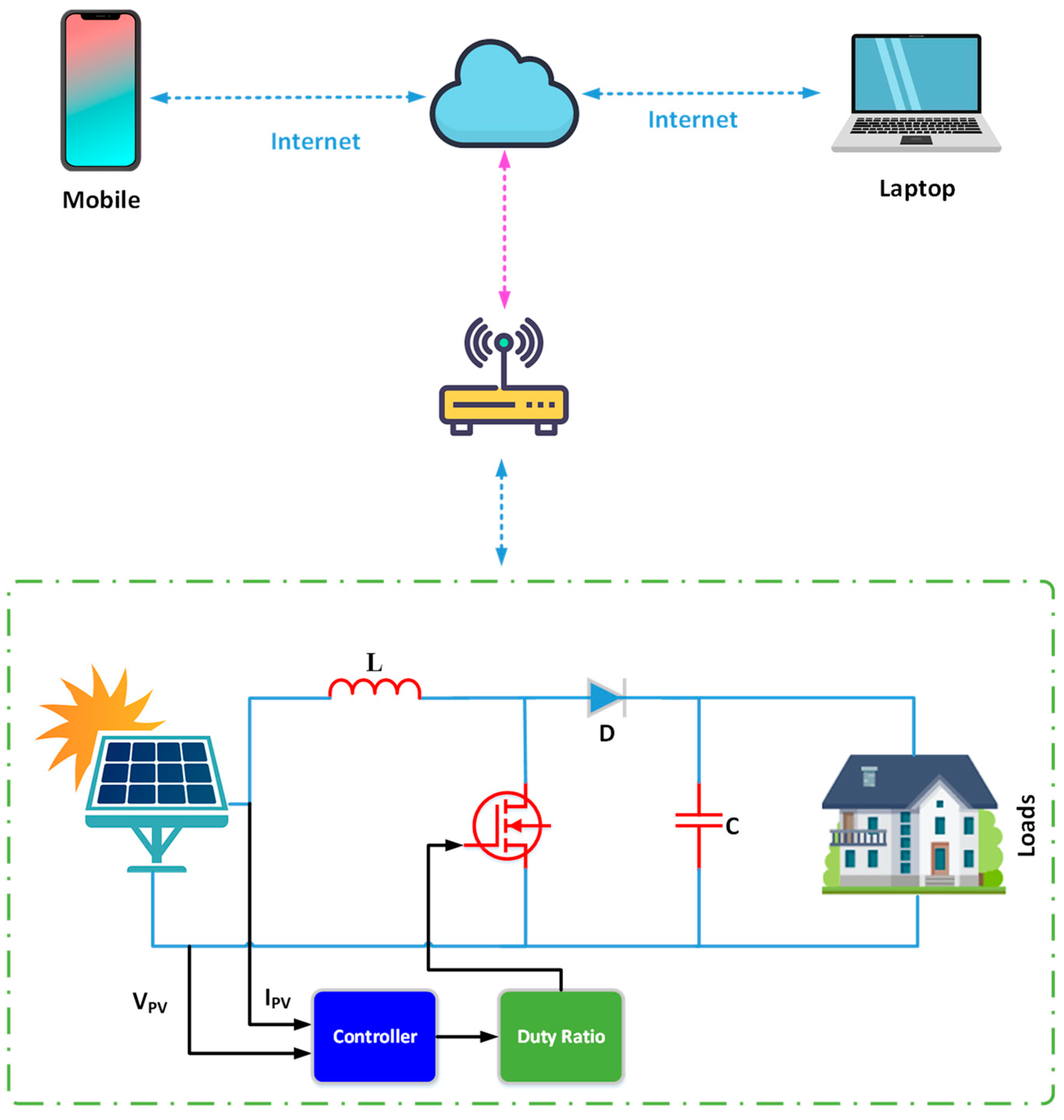
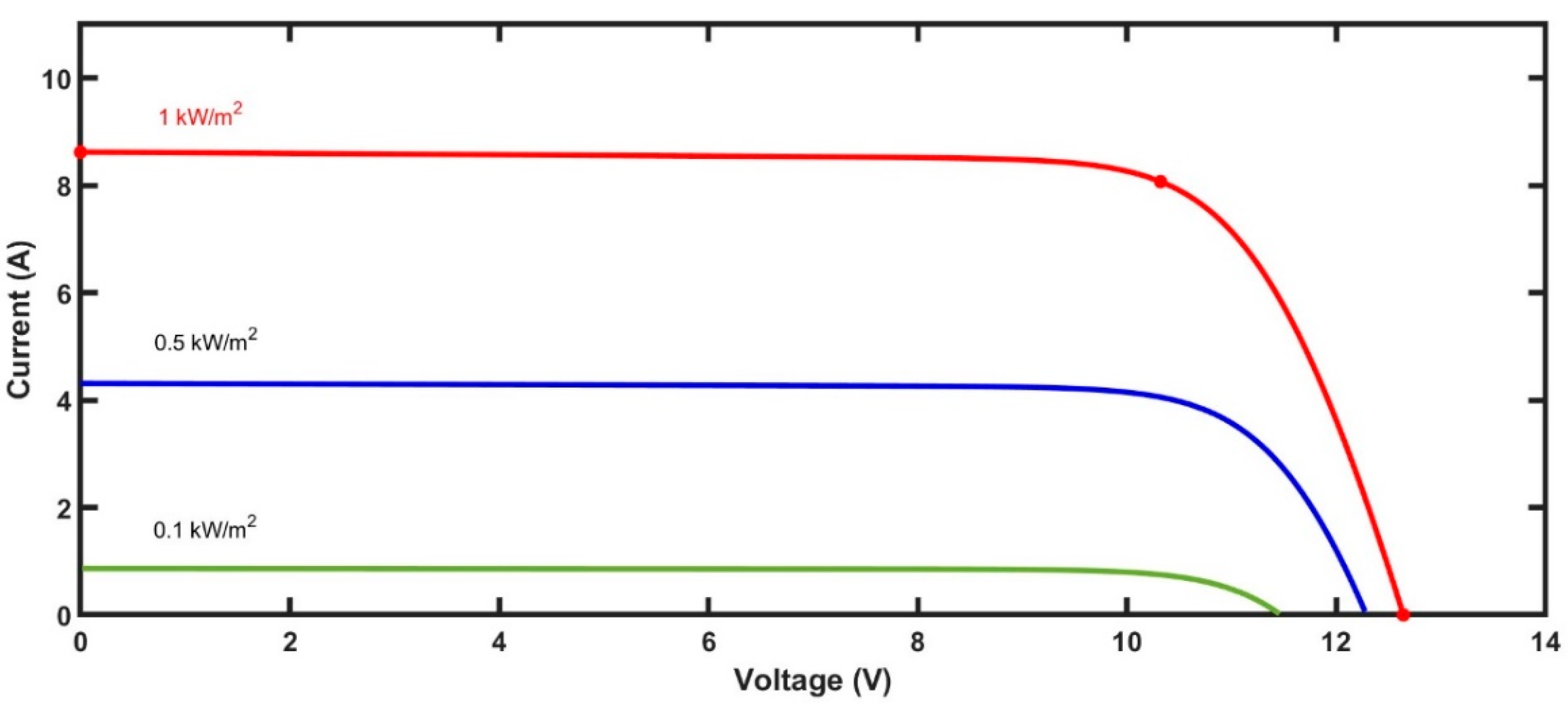

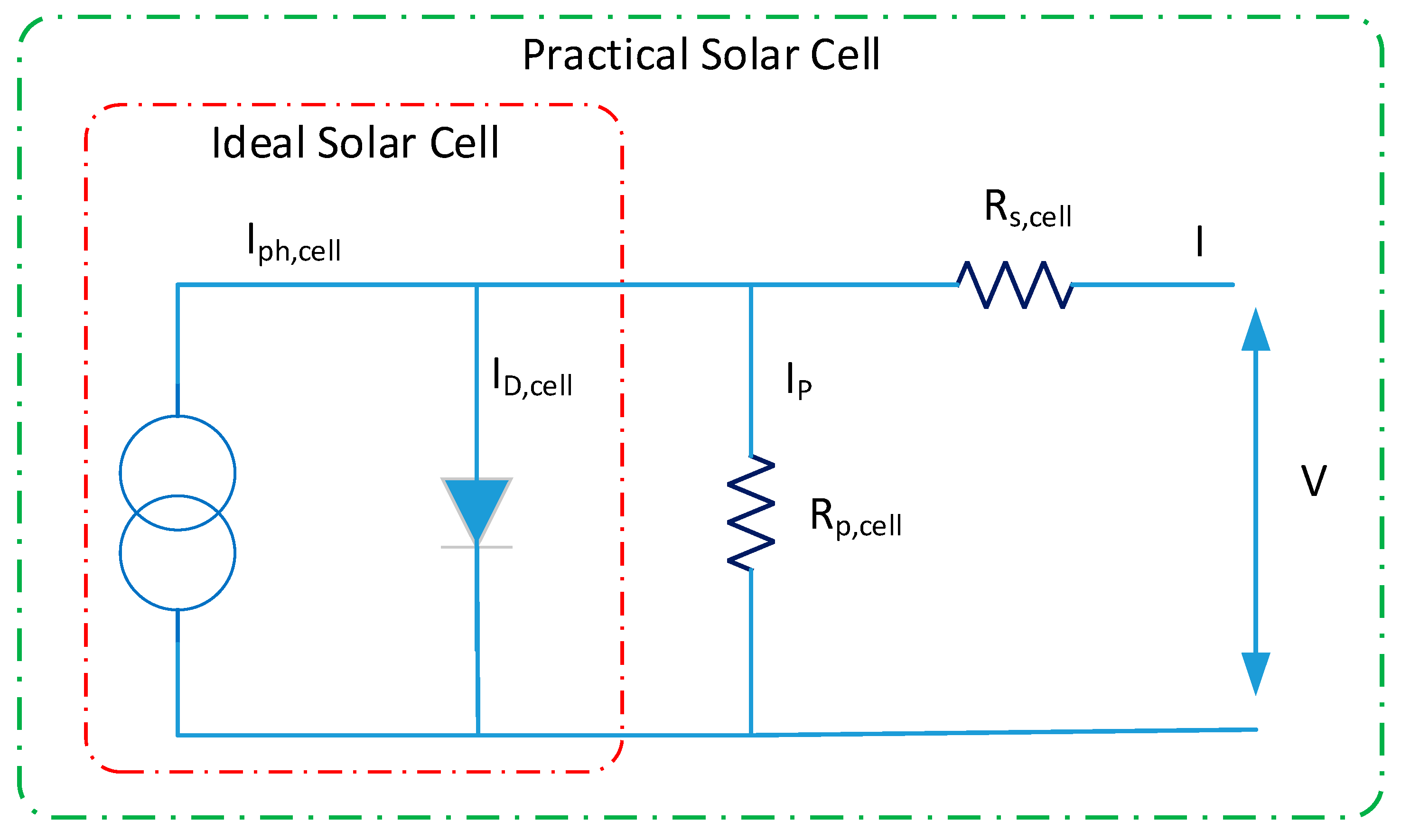
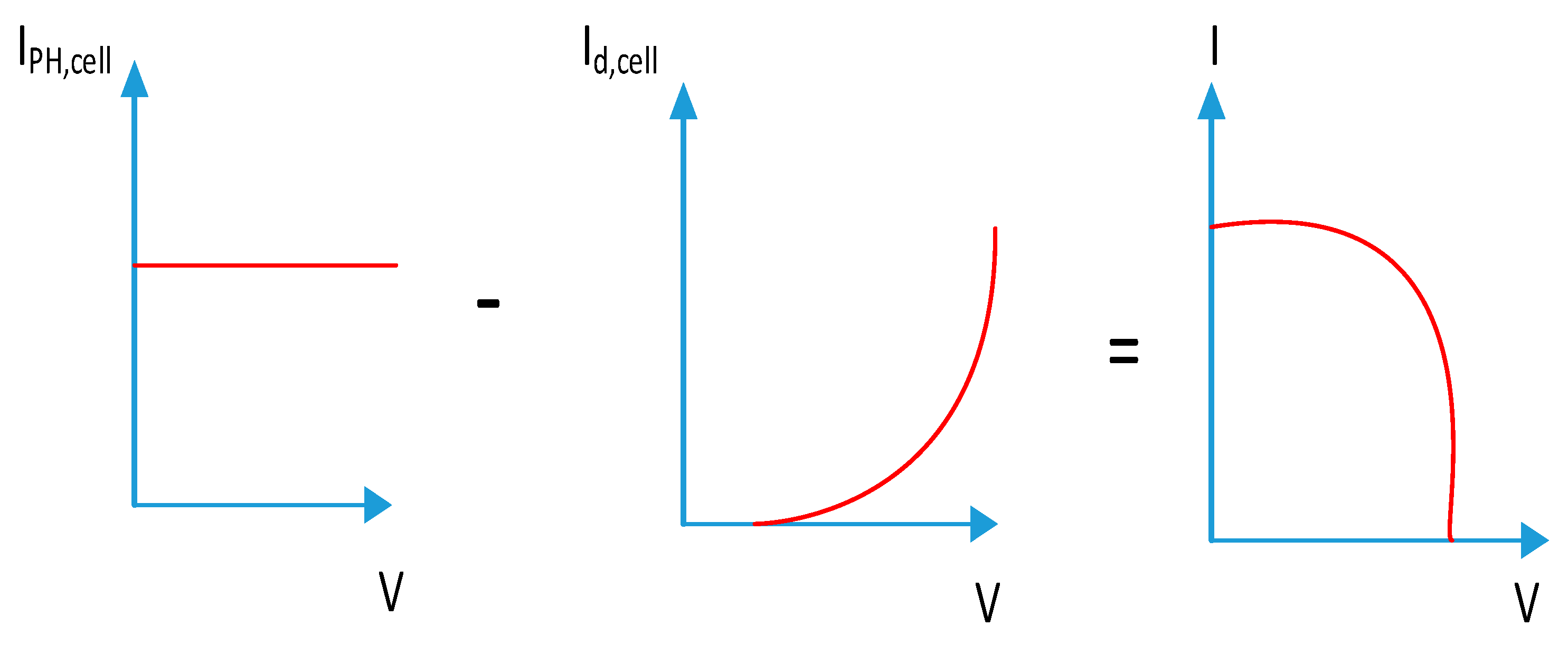
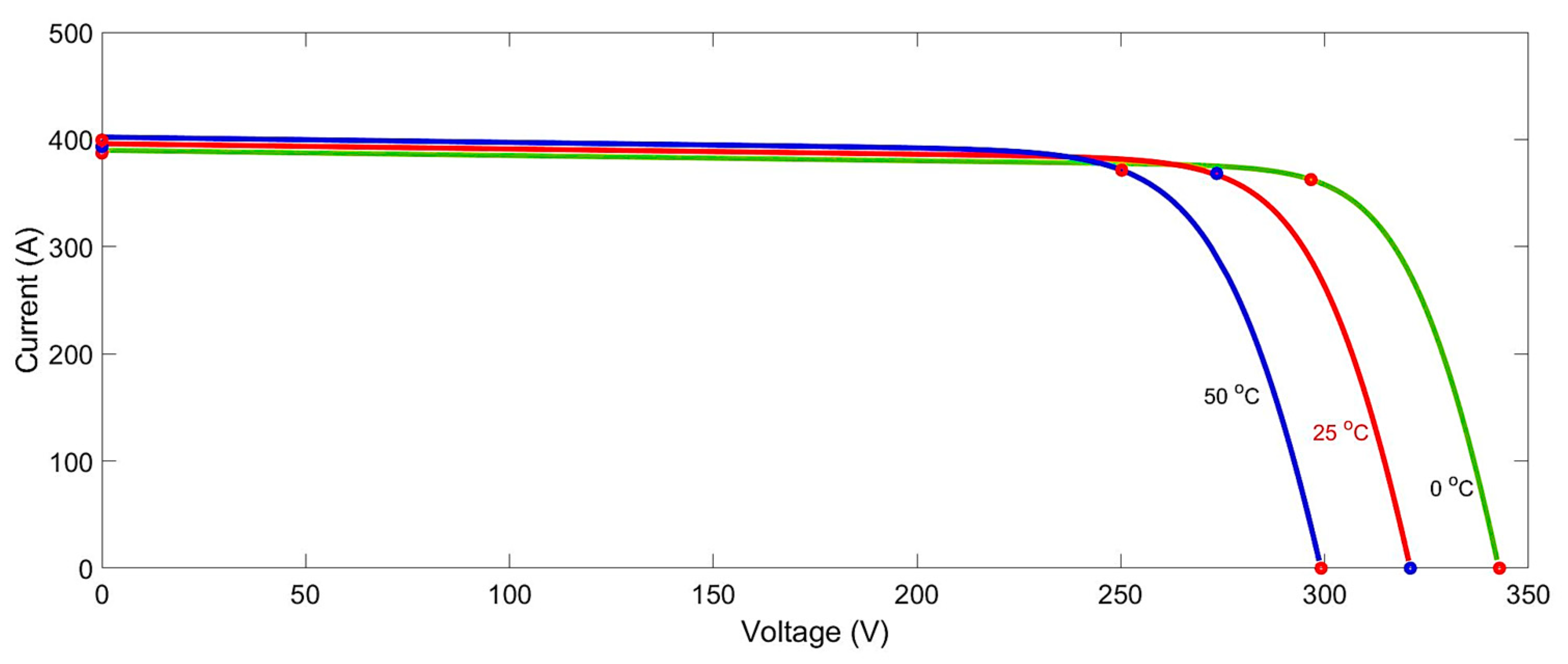
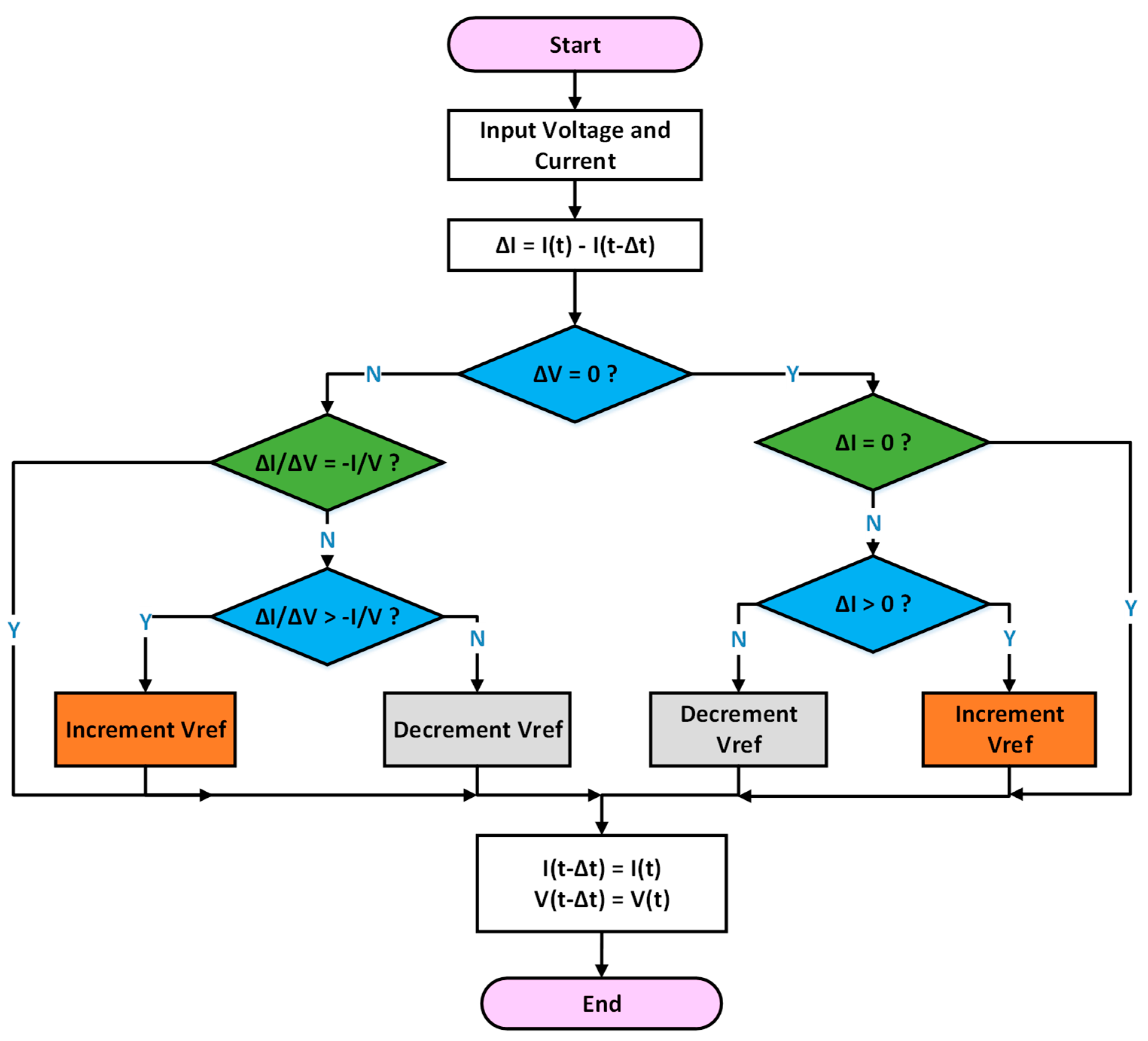
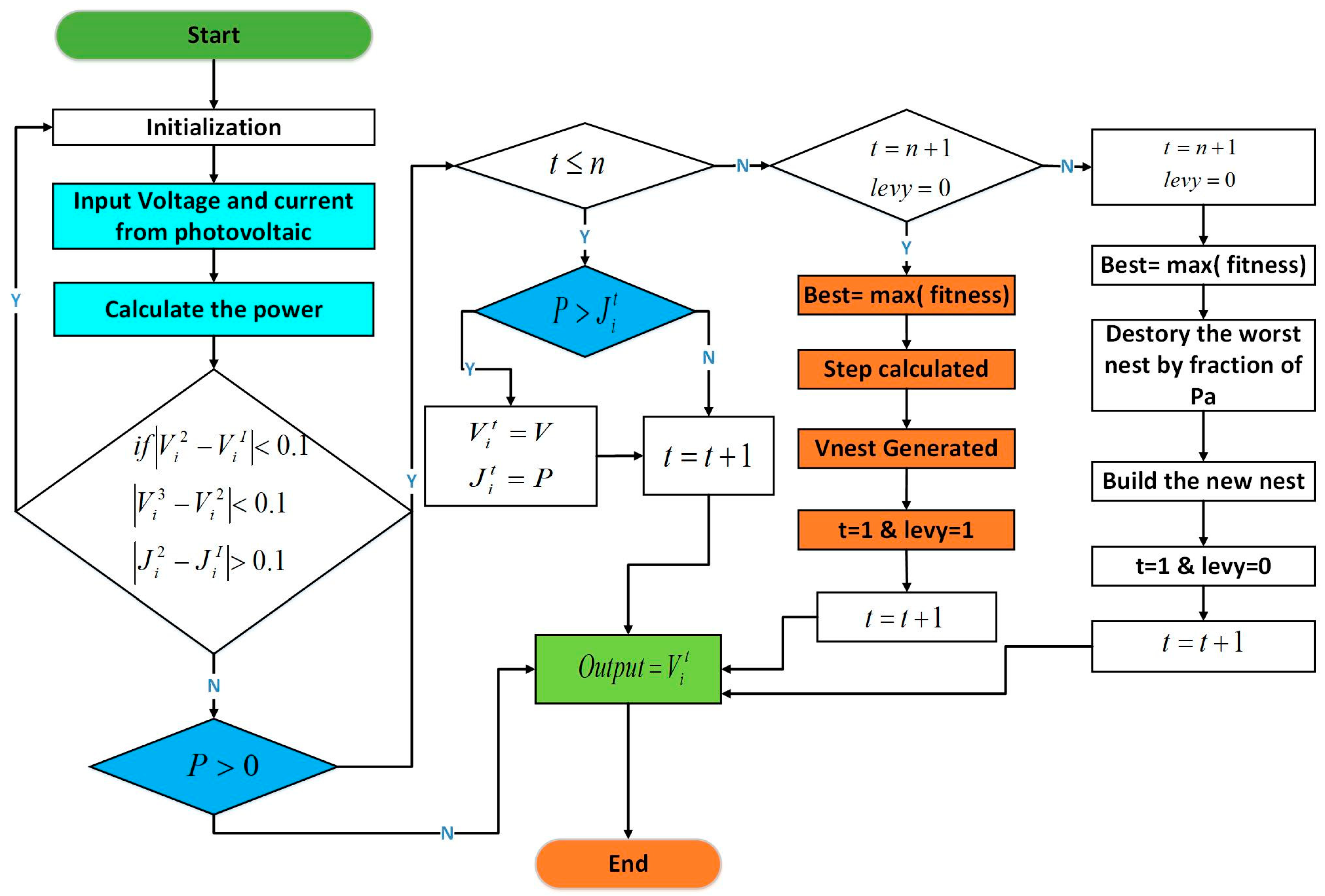
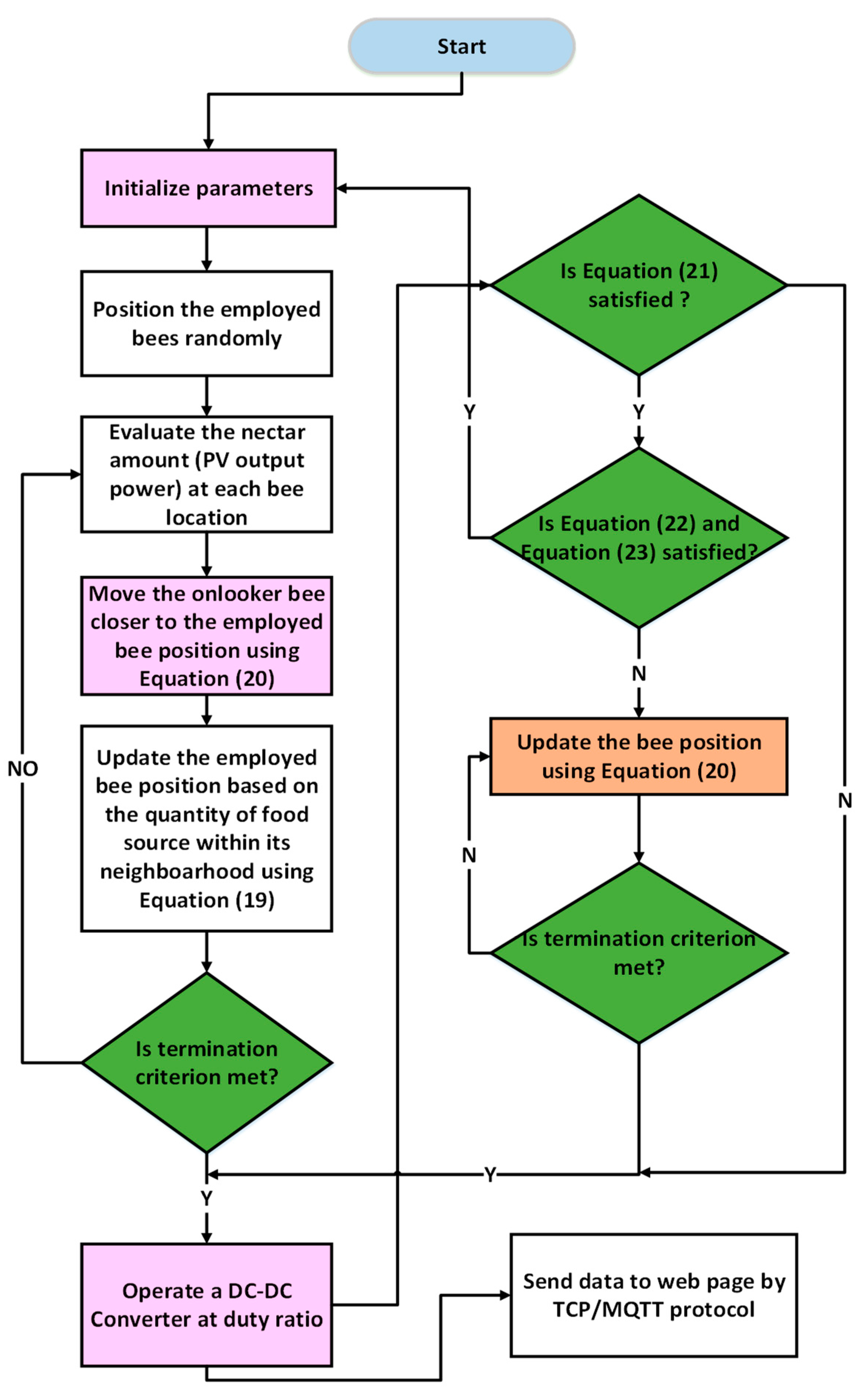

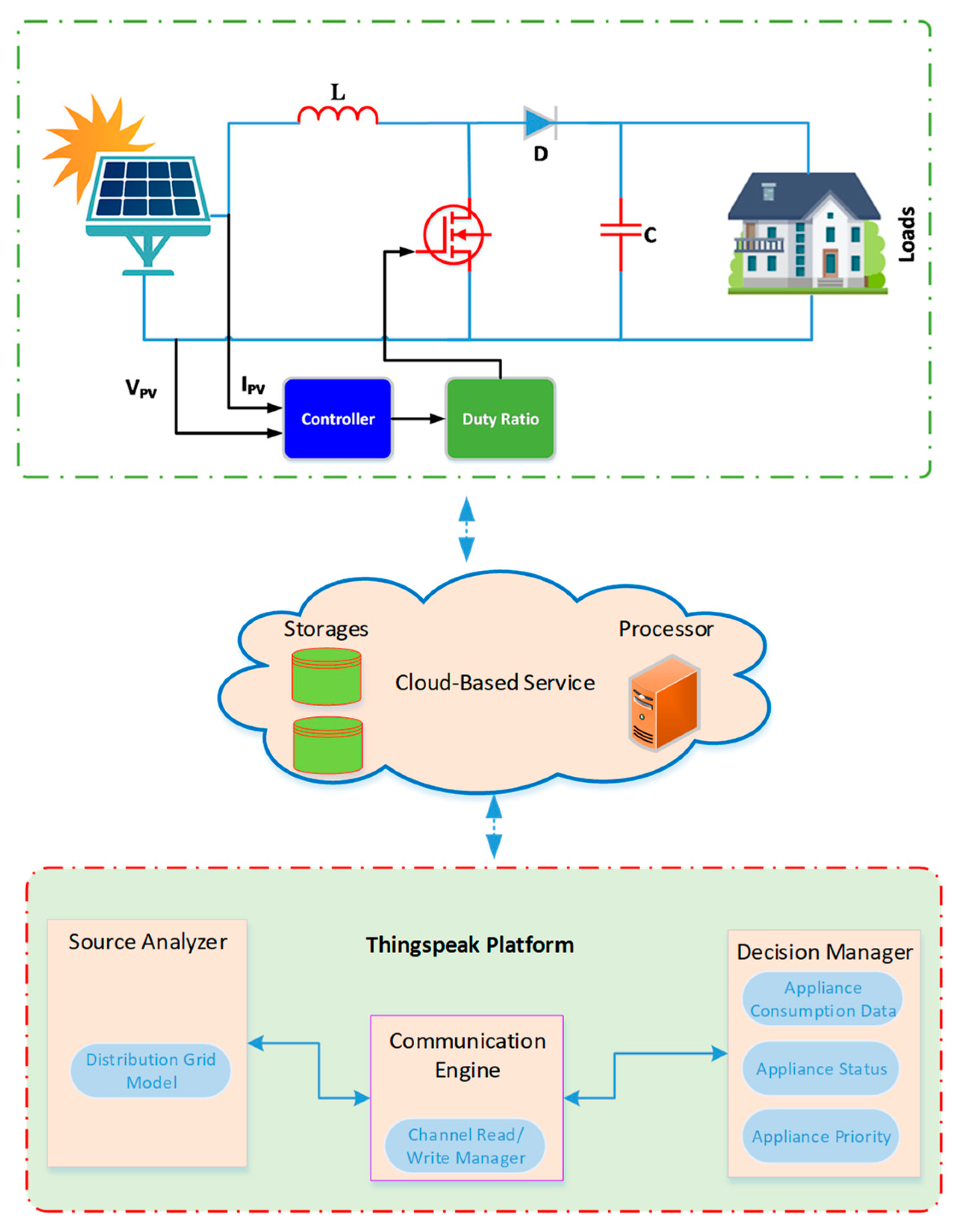
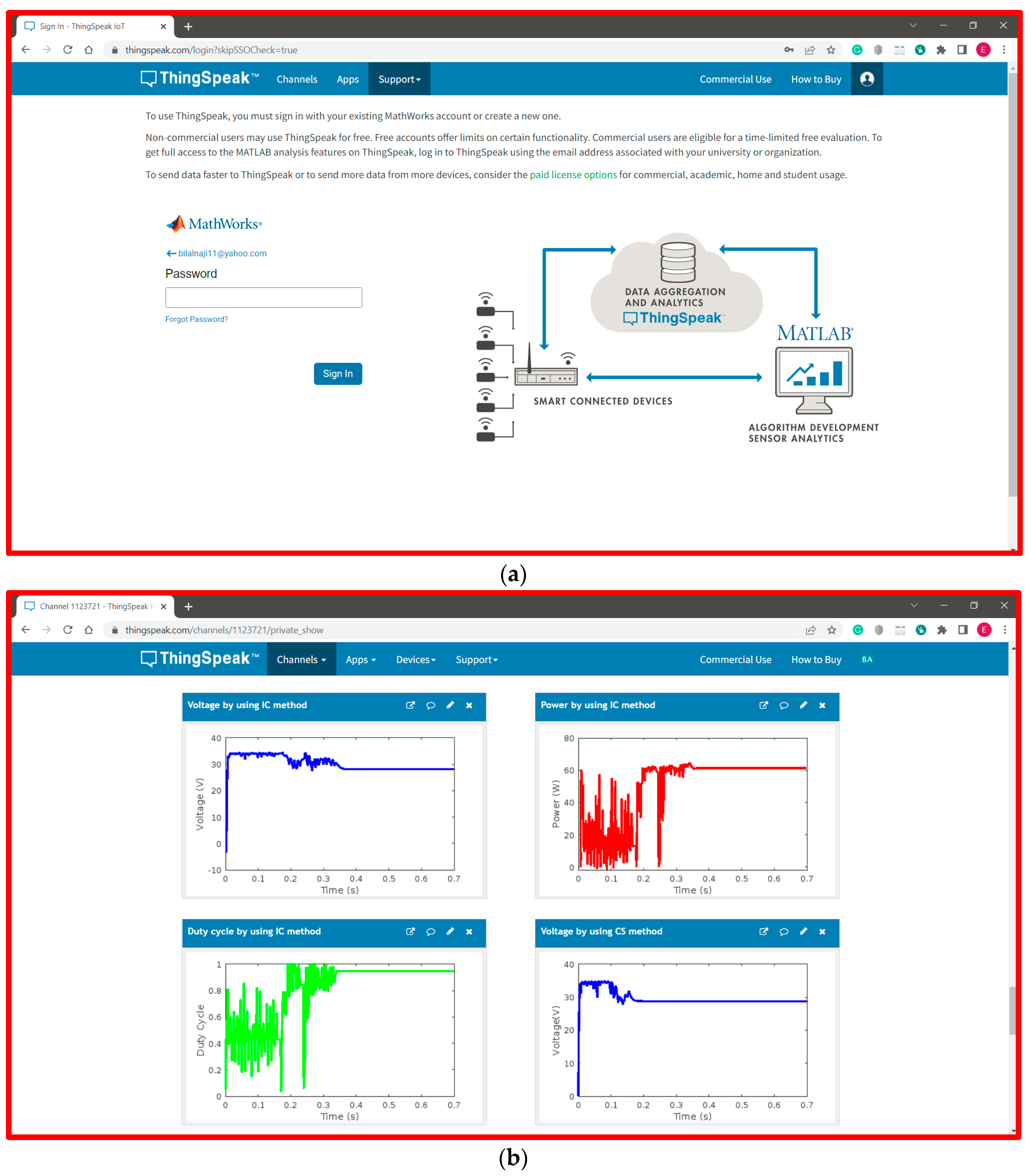
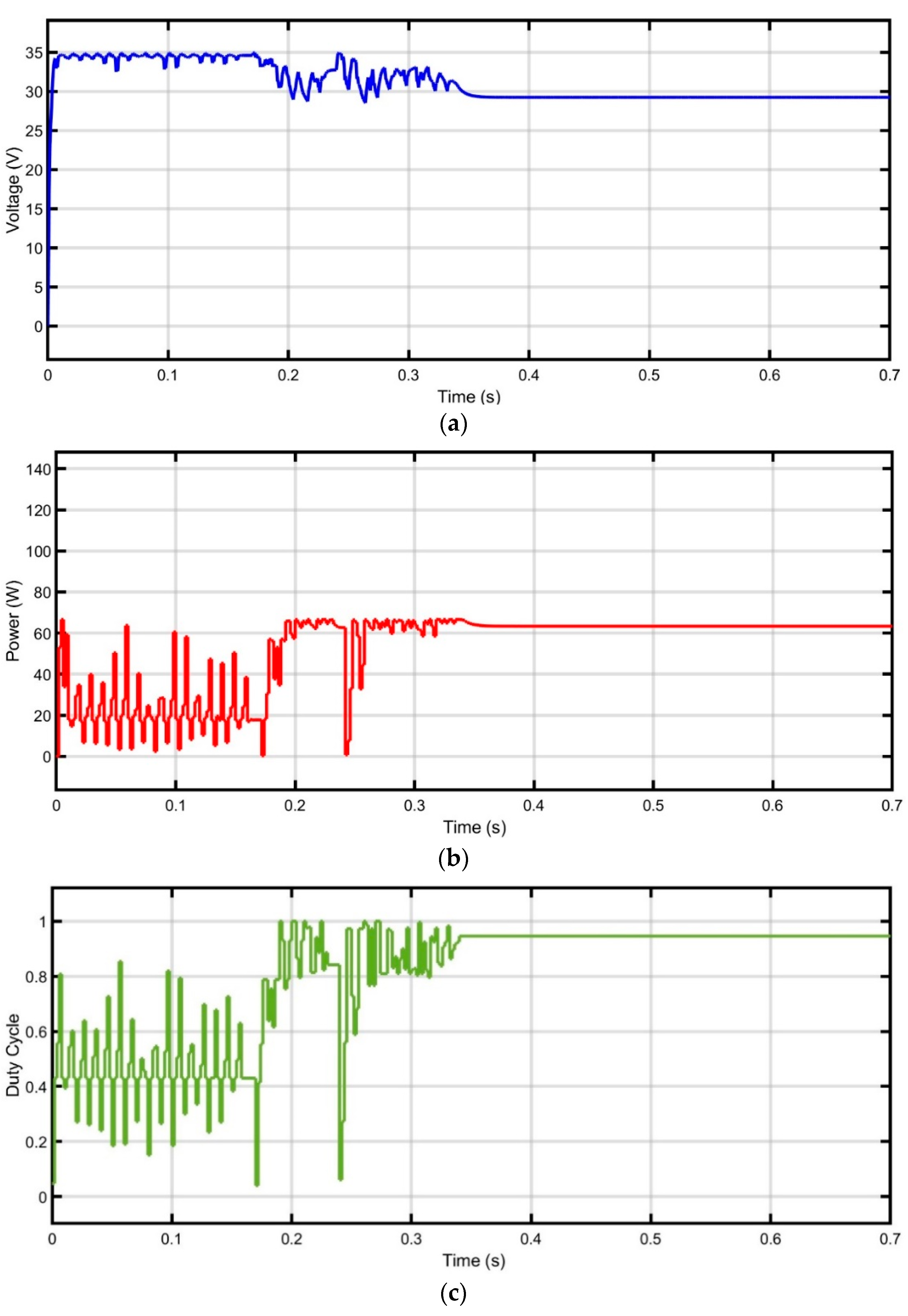
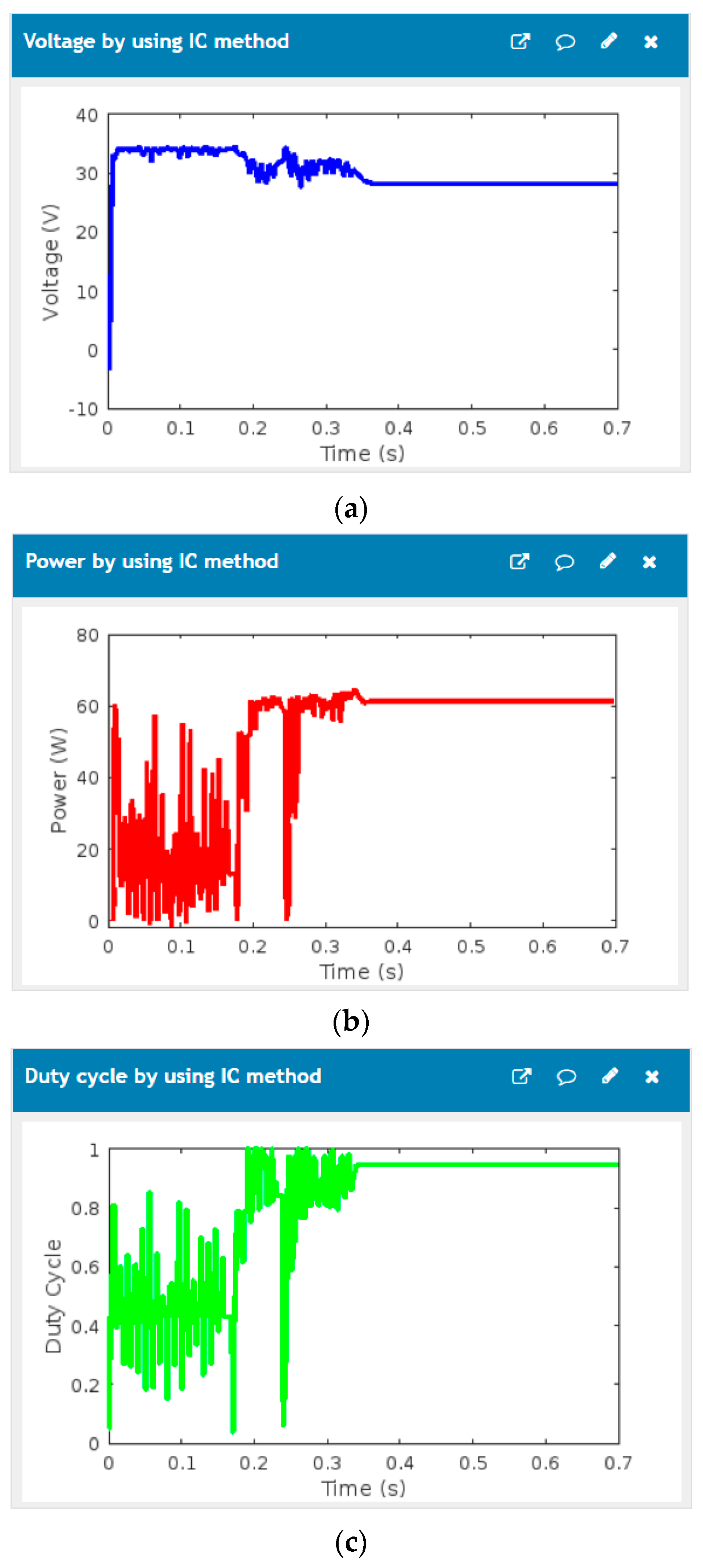
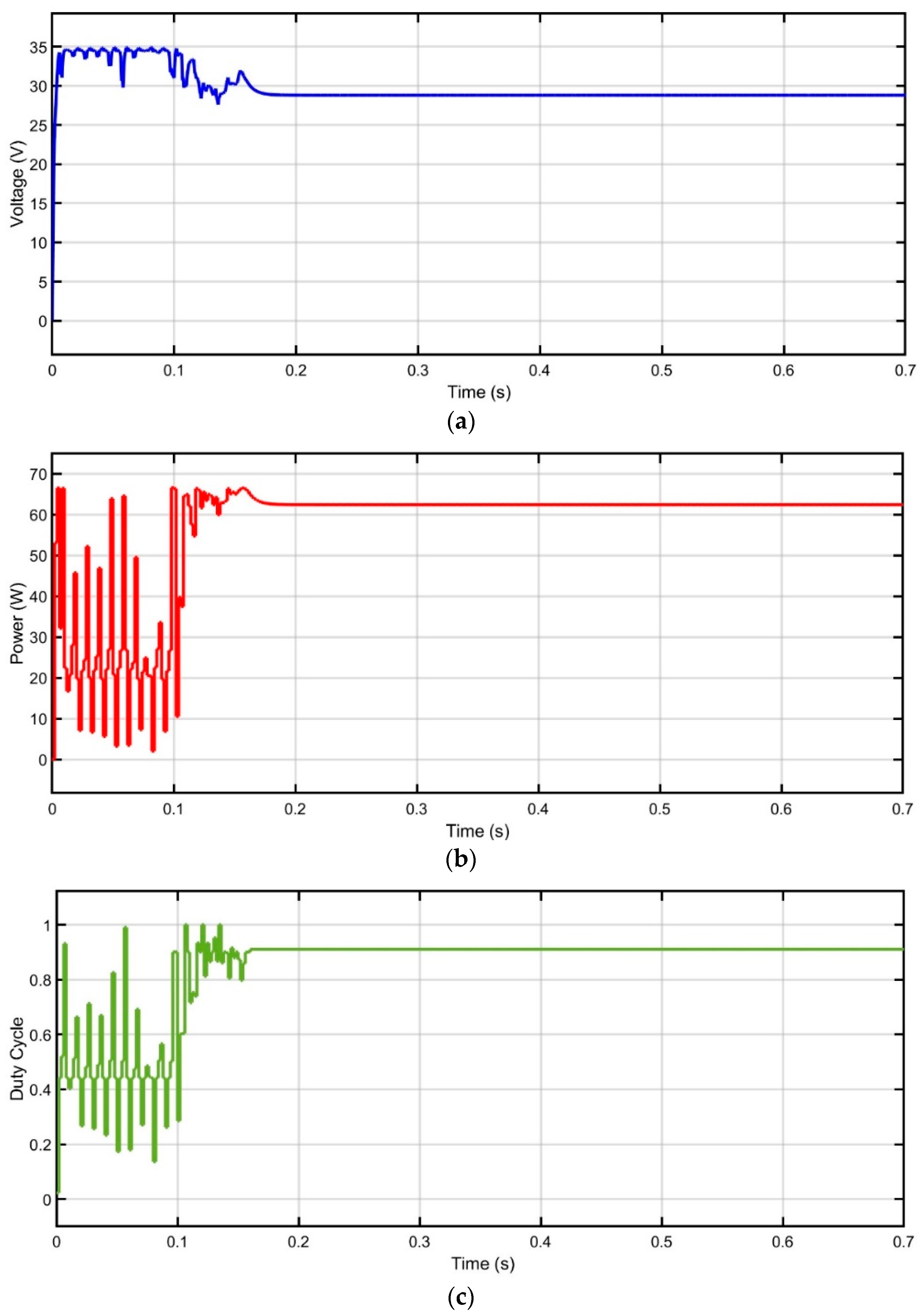
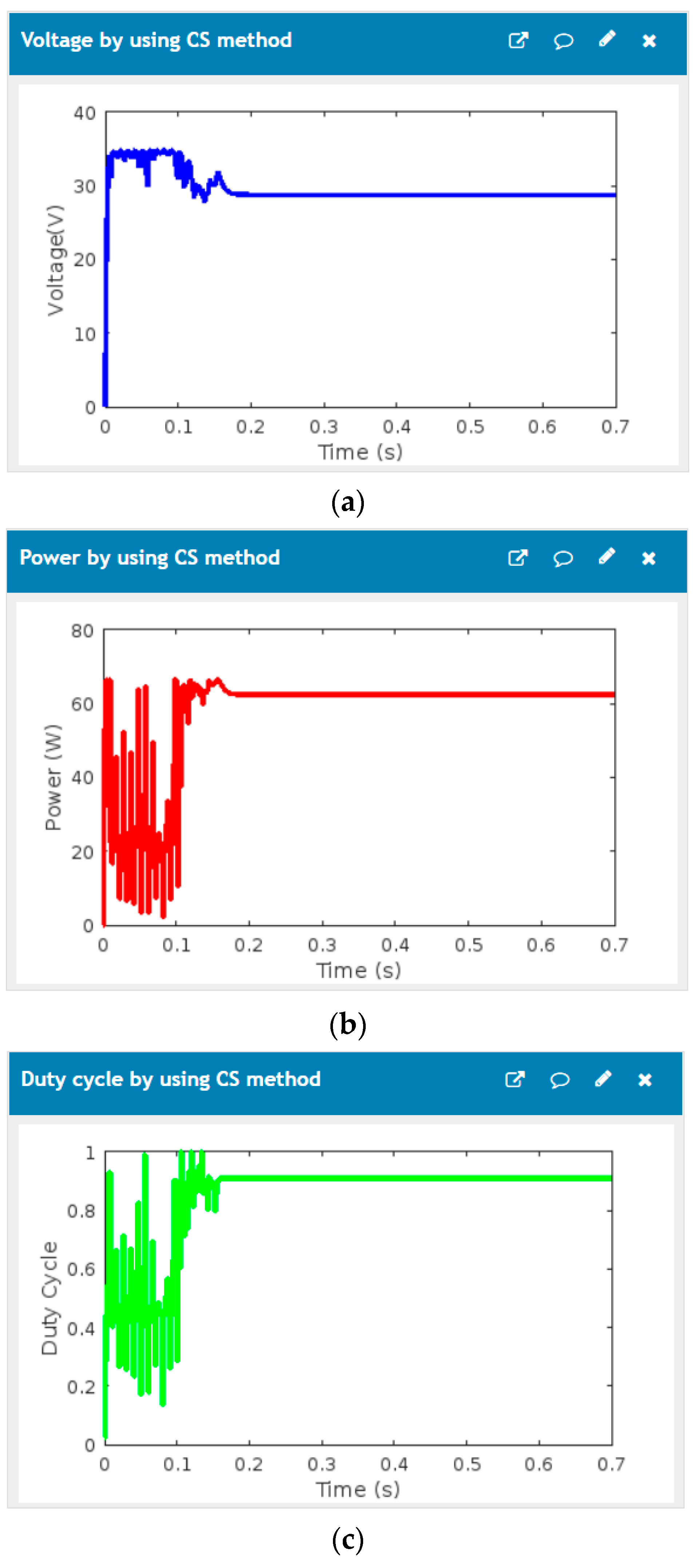
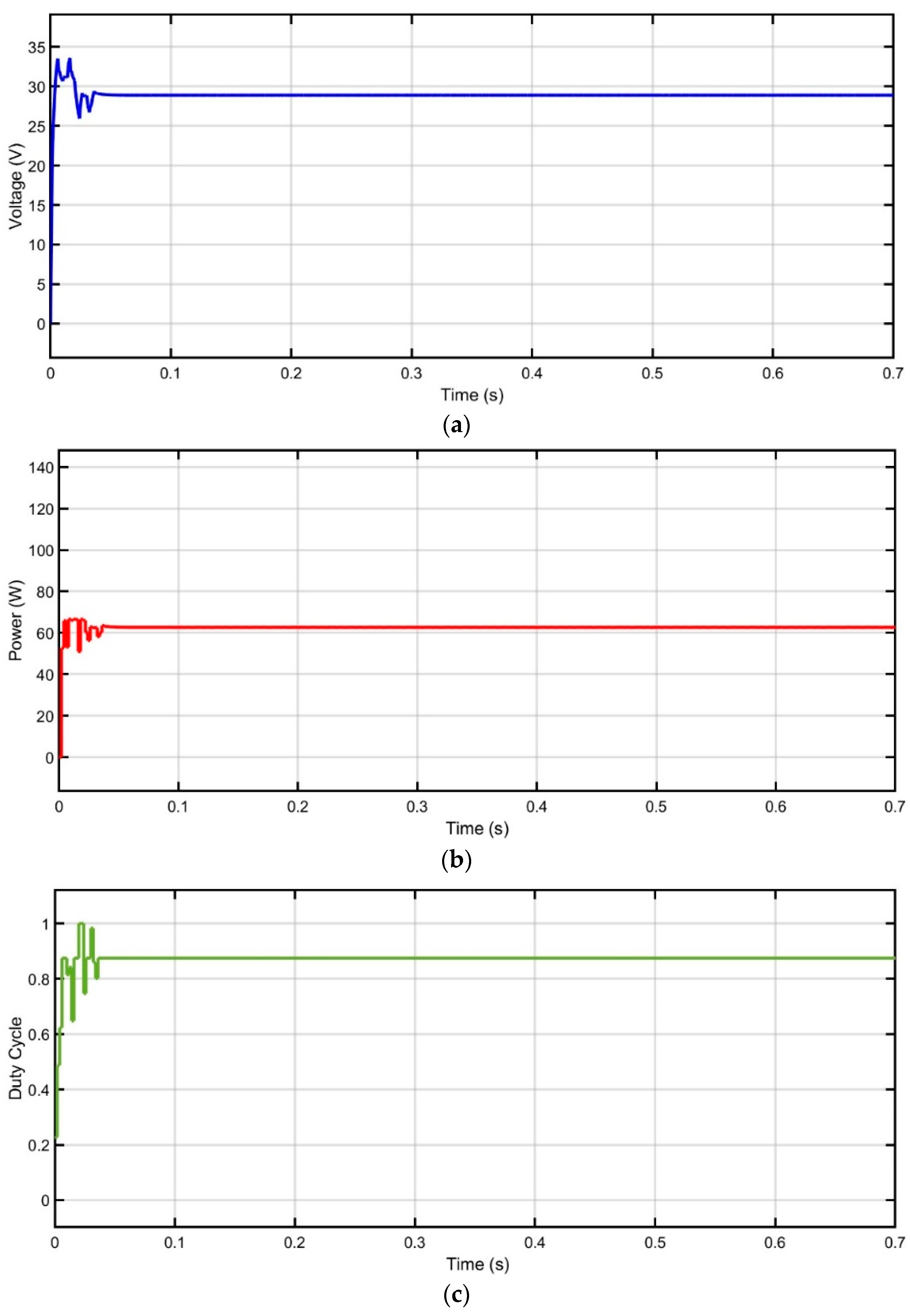
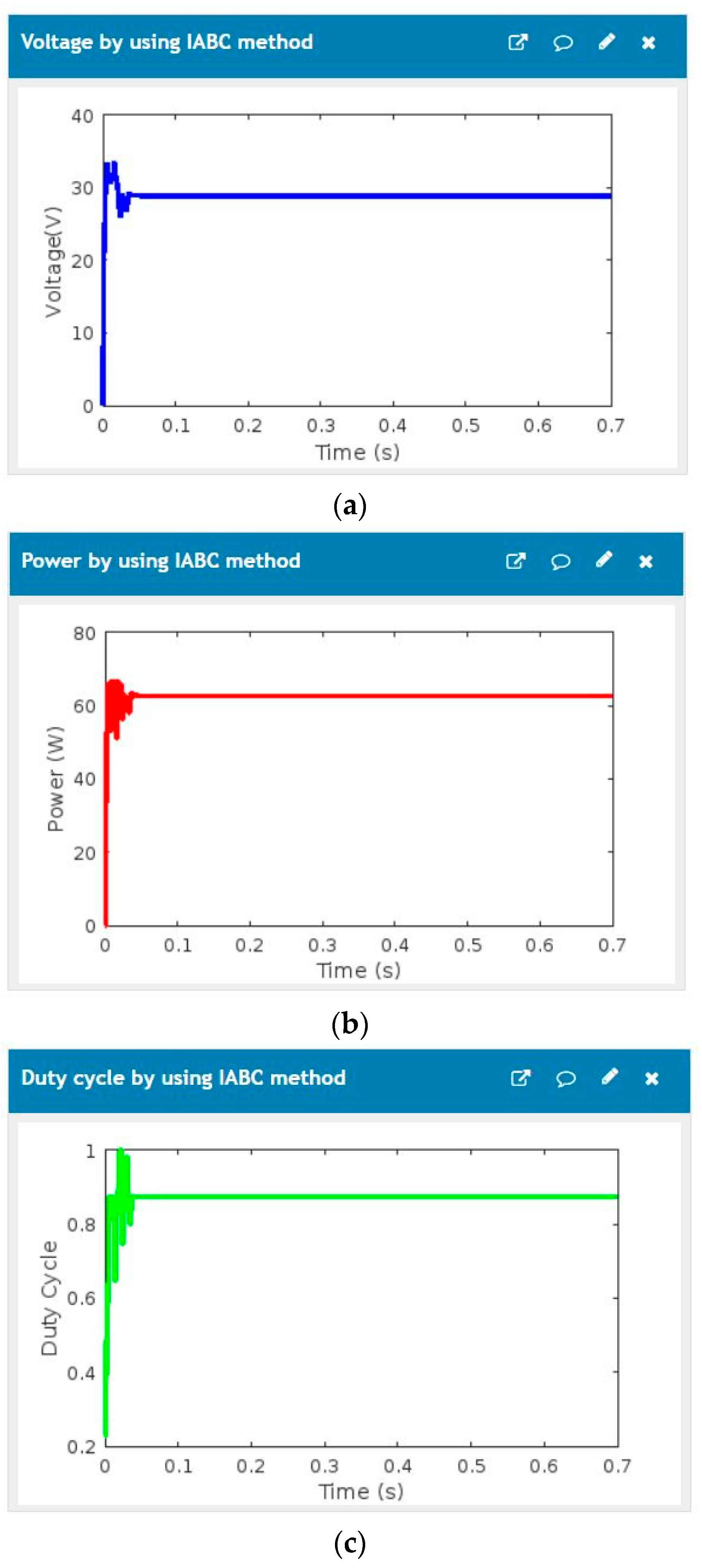
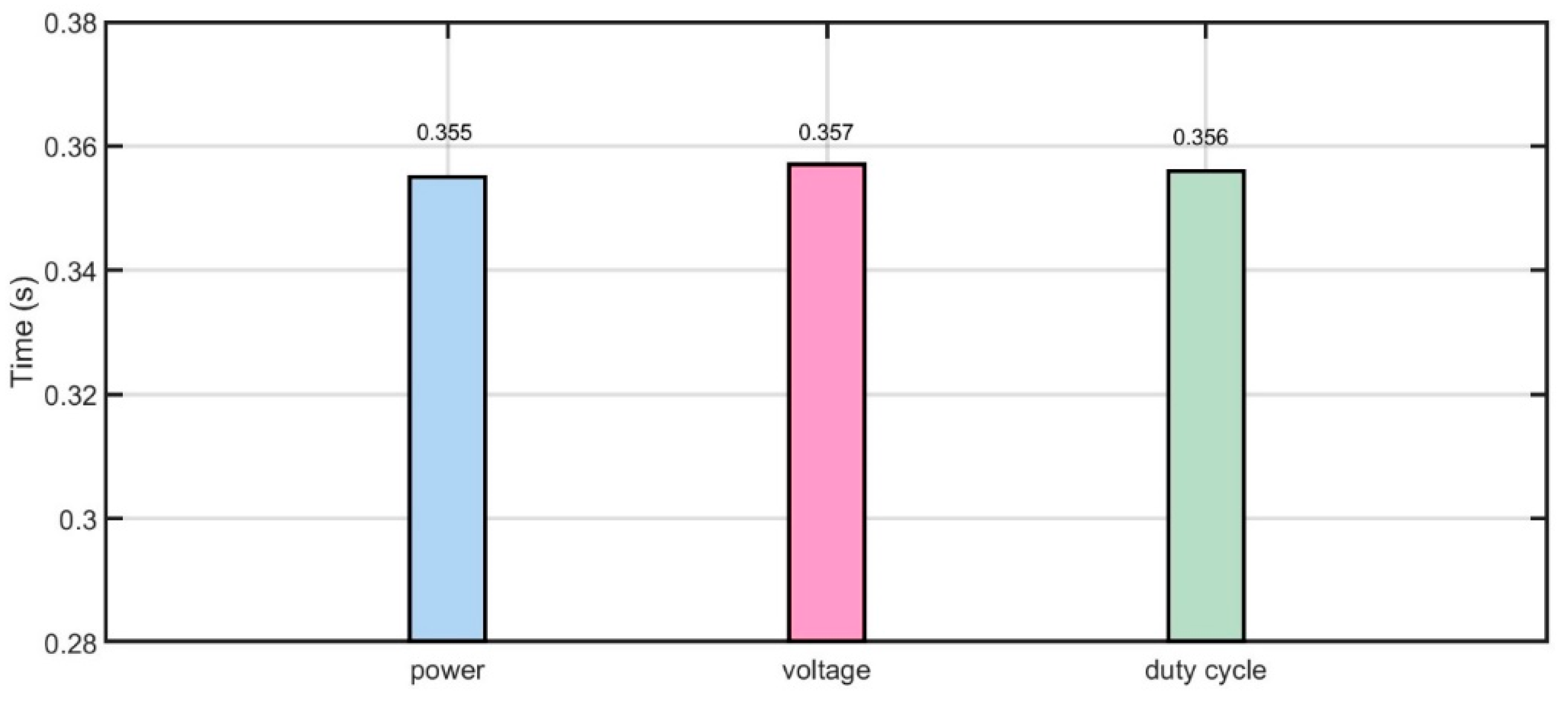
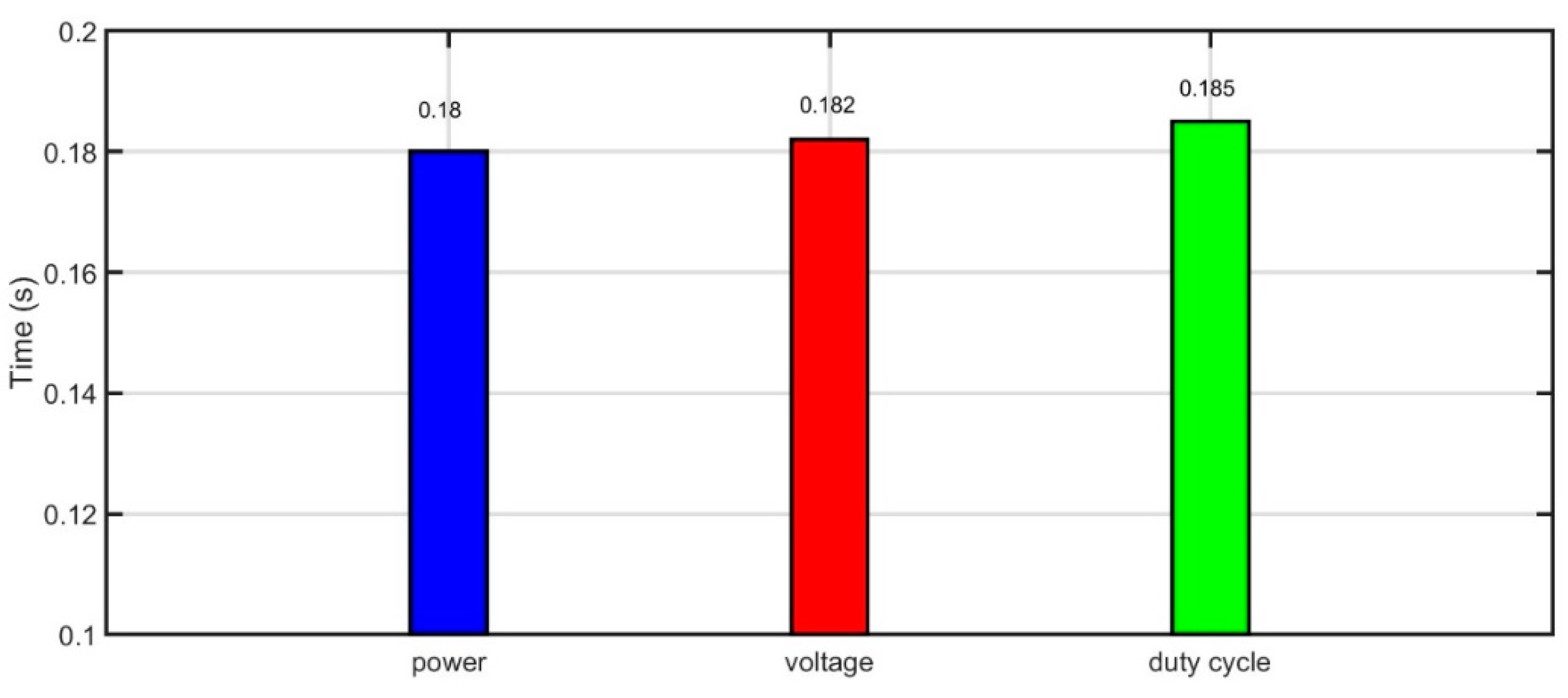
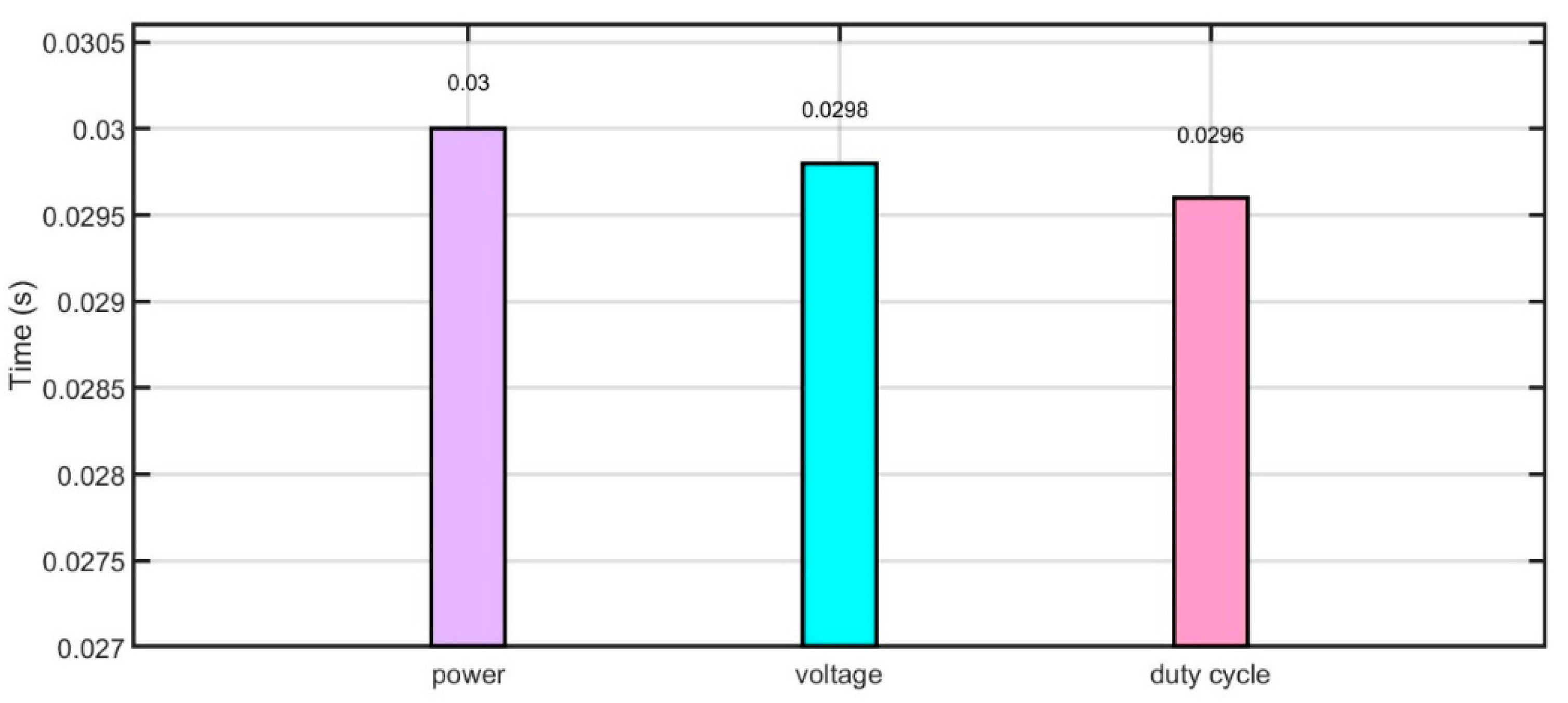
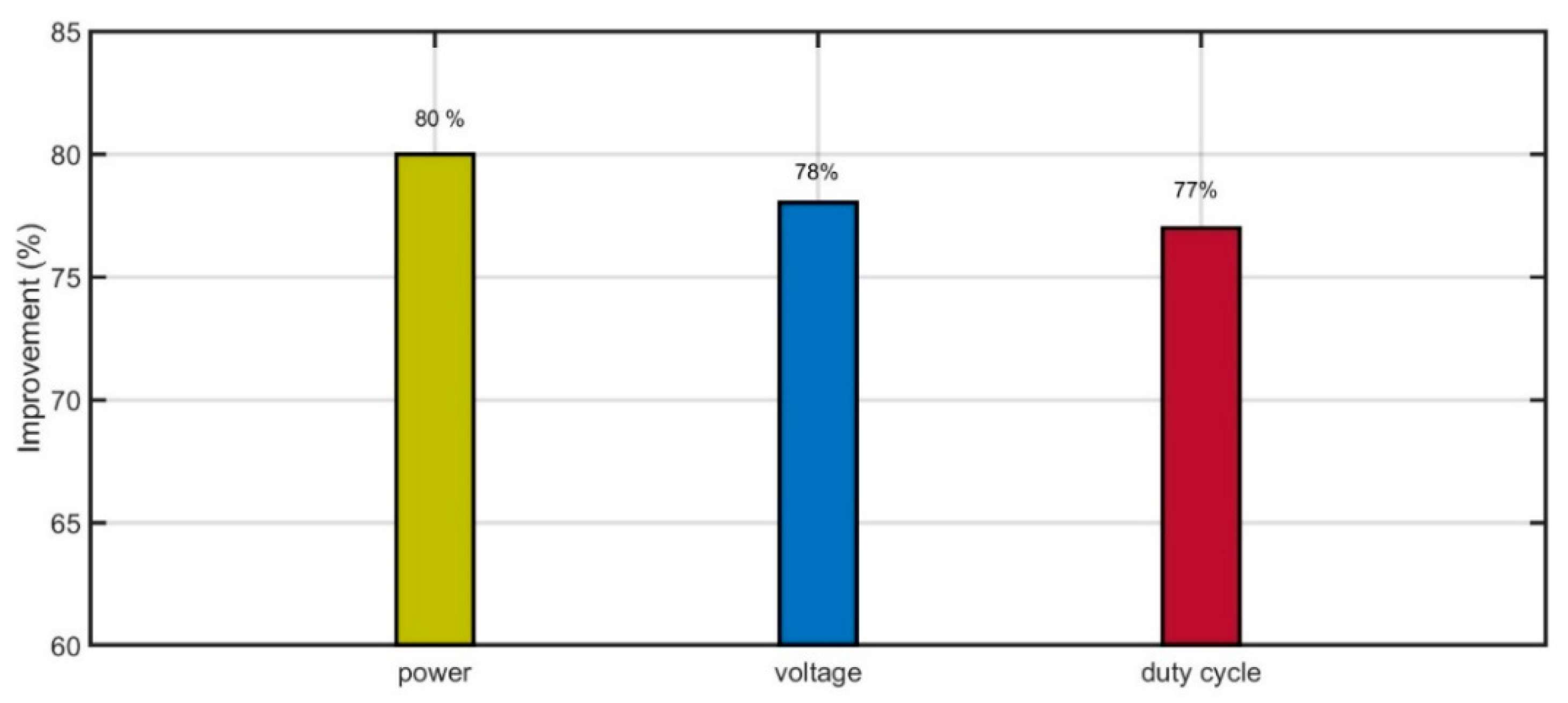
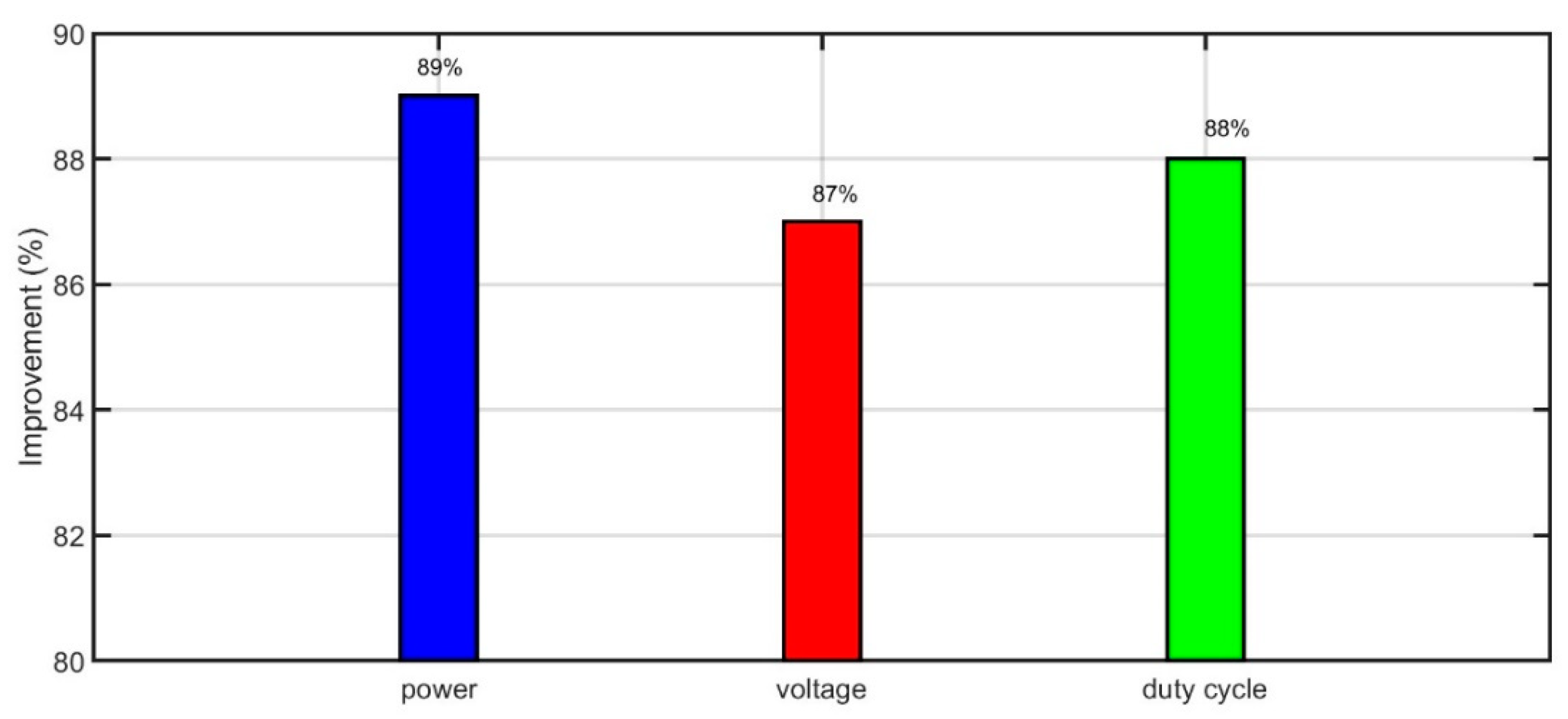
| Ref. | Achievements | Advantages | Limitations |
|---|---|---|---|
| [9] |
|
|
|
| [10] |
|
|
|
| [11] |
|
|
|
| [12] |
|
|
|
| [13] |
|
|
|
| [14] |
|
|
|
| [15] |
|
|
|
| [16] |
|
|
|
| [17] |
|
|
|
| [18] |
|
|
|
| [19] |
|
|
|
| [20] |
|
|
|
| [21] |
|
|
|
| [22] |
|
|
|
| [23] |
|
|
|
| [24] |
|
|
|
| [25] |
|
|
|
| [26] |
|
|
|
| [27] |
|
|
|
| [28] |
|
|
|
| [29] |
|
|
|
| Steady-State Restoration Time | Power (w) | Voltage (V) | Duty Cycle |
|---|---|---|---|
| Steady-state restoration time using IC method | 0.355 (s) | 0.357 (s) | 0.356 (s) |
| Steady-state restoration time using cuckoo search method | 0.18 (s) | 0.182 (s) | 0.185 (s) |
| Steady-state restoration time using IABC method | 0.03 (s) | 0.0298 (s) | 0.0296 (s) |
Publisher’s Note: MDPI stays neutral with regard to jurisdictional claims in published maps and institutional affiliations. |
© 2022 by the authors. Licensee MDPI, Basel, Switzerland. This article is an open access article distributed under the terms and conditions of the Creative Commons Attribution (CC BY) license (https://creativecommons.org/licenses/by/4.0/).
Share and Cite
Alhasnawi, B.N.; Jasim, B.H.; Alhasnawi, A.N.; Sedhom, B.E.; Jasim, A.M.; Khalili, A.; Bureš, V.; Burgio, A.; Siano, P. A Novel Approach to Achieve MPPT for Photovoltaic System Based SCADA. Energies 2022, 15, 8480. https://doi.org/10.3390/en15228480
Alhasnawi BN, Jasim BH, Alhasnawi AN, Sedhom BE, Jasim AM, Khalili A, Bureš V, Burgio A, Siano P. A Novel Approach to Achieve MPPT for Photovoltaic System Based SCADA. Energies. 2022; 15(22):8480. https://doi.org/10.3390/en15228480
Chicago/Turabian StyleAlhasnawi, Bilal Naji, Basil H. Jasim, Arshad Naji Alhasnawi, Bishoy E. Sedhom, Ali M. Jasim, Azam Khalili, Vladimír Bureš, Alessandro Burgio, and Pierluigi Siano. 2022. "A Novel Approach to Achieve MPPT for Photovoltaic System Based SCADA" Energies 15, no. 22: 8480. https://doi.org/10.3390/en15228480
APA StyleAlhasnawi, B. N., Jasim, B. H., Alhasnawi, A. N., Sedhom, B. E., Jasim, A. M., Khalili, A., Bureš, V., Burgio, A., & Siano, P. (2022). A Novel Approach to Achieve MPPT for Photovoltaic System Based SCADA. Energies, 15(22), 8480. https://doi.org/10.3390/en15228480









